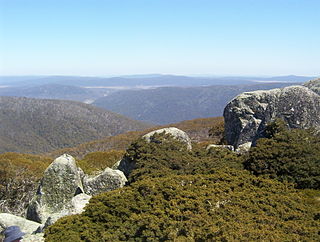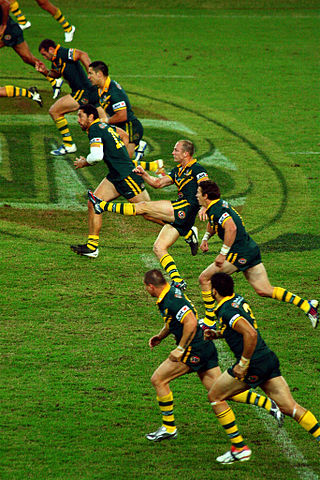
The Granville rail disaster occurred on Tuesday 18 January 1977 at Granville, a western suburb of Sydney, New South Wales, Australia, when a crowded commuter train derailed, running into the supports of a road bridge that collapsed onto two of the train's passenger carriages. The official inquiry found the primary cause of the crash to be poor fastening of the track.

The Snowy Mountains, known informally as "The Snowies", is an IBRA subregion in southern New South Wales, Australia, and is the tallest mountain range in mainland Australia, being part of the continent's Great Dividing Range cordillera system. It makes up the northeastern half of the Australian Alps and contains Australia's five tallest peaks, all of which are above 2,100 m (6,890 ft), including the tallest Mount Kosciuszko, which reaches to a height of 2,228 m (7,310 ft) above sea level. The offshore Tasmanian highlands makes up the only other major alpine region present in the whole of Australia.

Alpine Way is a 121-kilometre (75 mi) rural road located in the Snowy Mountains region of New South Wales, Australia. The road connects Jindabyne in the east to the New South Wales-Victorian border in the west, crossing the Murray River near Bringenbrong and Upper Towong.

Thredbo is a village and ski resort in the Snowy Mountains of New South Wales, Australia. It is approximately 500 kilometres (310 mi) south of Sydney, accessible by the Alpine Way via Cooma, Berridale and Jindabyne. The village is built in the valley of the Thredbo River, also known as the Crackenback River, at the foot of the Ramshead Range.

Charlotte Pass is a snow resort and village in the Snowy Mountains of New South Wales, Australia. The pass is in the Kosciuszko National Park where the Kosciuszko Road crosses Kangaroo Ridge. Charlotte Pass is the closest village to Mount Kosciuszko, the tallest mountain in Australia.

The Brindabella Range, commonly called The Brindabellas or The Brindies, is a mountain range located in Australia, on a state and territory border of New South Wales and the Australian Capital Territory (ACT). The range rises to the west of Canberra, the capital city of Australia, and includes the Namadgi National Park in the ACT and the Bimberi Nature Reserve and Brindabella National Park in New South Wales. The Brindabellas are visible to the west of Canberra and form an important part of the city's landscape.

Perisher Valley, commonly called Perisher, is a valley formed below Mount Perisher, a mountain that is located in the Snowy Mountains of New South Wales, Australia.

Bullocks Flat is a flat portion of the Thredbo Valley adjacent to the Thredbo River, in the Snowy Mountains region of New South Wales, Australia.
Stuart Diver is a ski instructor and was the sole survivor of the 1997 Thredbo landslide.

Guthega is an alpine village and the site for a hydro electric dam located in the Kosciuszko National Park, on the upper reaches of the Snowy River, on the western face of Mount Blue Cow, Snowy Mountains of New South Wales, Australia.

Winter Sports in Australia encompasses a great variety of activities across the continent of Australia, including winter sports played in snow and ice such as ice hockey. Climate varies considerably from the tropical North to temperate South in Australia, and sporting practices vary accordingly. Ice and snow sports like Skiing in Australia are conducted in the high country of the Australian Alps and Tasmanian Wilderness. Australia has relatively low mountain ranges, but a long history of participation in recreational skiing and the Winter Olympic Games. Australians have won olympic gold in ice skating, skiing and snow-boarding events. Australia's generally flat geography and usually mild winter climate otherwise provide ideal conditions for international non-snow/ice winter sports and team games like rugby union football, rugby league football, and association football (soccer), which are all popular sports during the Australian winter and in which Australia has enjoyed considerable international success. Australian rules football is a home-grown winter football code with a wide following throughout Australia. Many other sports are also played or watched in Australia through the winter season.
Sport in New South Wales describes participation in and attendance at organised sports events in the state of New South Wales in Australia. Sport forms an integral part of the culture of the state.

Mount Gingera is a mountain with an elevation of 1,857 metres (6,093 ft) AHD located within the Brindabella Range on the border between the Australian Capital Territory and New South Wales in Australia. The summit of the mountain is located within the ACT, and is the second highest peak in the territory.

Seaman's Hut is an alpine hut and memorial located in New South Wales, Australia. It was built following the death of two skiers, W. Laurie Seaman and Evan Hayes in 1928. Seaman's family built the hut to provide shelter to future users of the park, in order to prevent recurrence of a similar tragedy, which has since done.

Skiing in Australia takes place in the Australian Alps in the states of New South Wales, Victoria and the Australian Capital Territory as well as in the mountains of the island state Tasmania, during the Southern Hemisphere winter.

Skiing in New South Wales takes place in the high country of the Snowy Mountains of New South Wales during the Southern Hemisphere winter.

Skiing in the Australian Capital Territory refers to snow skiing in the Australian Capital Territory (ACT). The highest mountain in the ACT is Bimberi Peak. Recreational skiing commenced with the formation of the Canberra Alpine Club in 1934. Since the 1930s, the ACT has had intermittent and limited alpine skiing facilities. Downhill ski facilities returned to the ACT at Corin Forest in 2016, after a two decade hiatus.
New South Wales Urban Search and Rescue Task Force 1 was first established as a USAR capability in the lead up to the 2000 Sydney Olympics. After earlier large-scale collapses including the 1977 Granville Train Disaster, 1989 Newcastle earthquake and 1997 Thredbo landslide, Fire & Rescue NSW was legislated as the combat authority for responding to major structural collapse incidents within the state of New South Wales.
Kosciusko Alpine Club (KAC) is the second oldest ski club in Australia after the Kiandra Pioneer Ski Club (1861). It was founded in 1909, two months after the NSW Government opened the Hotel Kosciusko at Diggers Creek, the first hotel in the Kosciusko area. The Hotel Kosciusko became the winter home of KAC until 1930 when the Kosciusko Chalet opened at Charlotte's Pass. KAC was the only ski club in the Kosciuszko area until 1920 when the Ski Club of Australia was formed.
A landslide occurred in the early hours of 16 December 2022 near the Malaysian town of Batang Kali, Selangor, displacing 450,000 m3 (16 million cu ft) of soil and burying campsites at an organic farm. The accident trapped 92 people under the collapsed slope; most were campers from the farm. 31 people were killed and 61 were rescued, with 8 people requiring hospitalisation.















